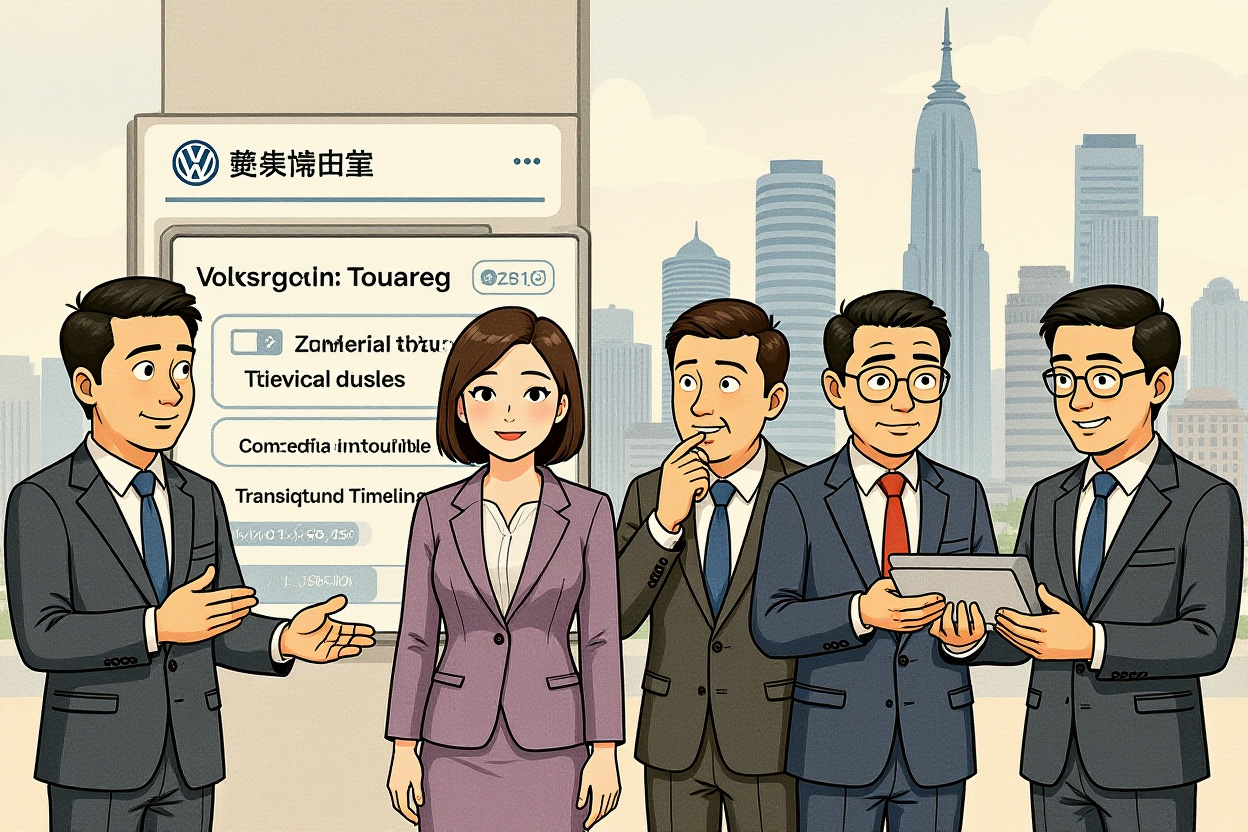Volkswagen’s Flagship SUV Exits Chinese Market After Two Decades
Volkswagen Group has announced it will cease supplying its flagship Touareg model to the Chinese market starting November 2025, marking the end of a two-decade presence for one of Germany’s most iconic luxury SUVs. The decision comes as sales have consistently declined in recent years, despite price reductions and the vehicle’s historically strong reputation. This move reflects broader challenges facing traditional internal combustion engine vehicles in China’s rapidly evolving automotive landscape, where electric and hybrid models are increasingly dominating consumer preferences.
The Volkswagen Touareg discontinuation in China represents a significant moment for the automaker’s market strategy in the world’s largest automotive market. Once a symbol of premium German engineering and status, the Touareg’s fading appeal highlights how quickly consumer tastes and competitive dynamics are shifting in China’s premium SUV segment. For international investors and automotive industry professionals, this development offers important insights into the future direction of both Volkswagen’s China strategy and the broader premium vehicle market.
Historical Significance and Market Performance
The Touareg first launched in 2002 as Volkswagen’s entry into the premium SUV segment, developed alongside the Porsche Cayenne and Audi Q7 through a collaborative platform sharing strategy. This approach allowed Volkswagen to leverage engineering expertise across brands while establishing the Touareg as a legitimate competitor in the luxury SUV space.
Peak Performance and Premium Positioning
During its heyday, the Touareg commanded impressive price points and sales volumes in China:
– Reached price points as high as 1.58 million RMB ($218,000) at peak positioning
– Achieved monthly sales exceeding 10,000 units during strongest market periods
– Established itself as the flagship model representing Volkswagen’s premium aspirations
The vehicle’s initial success demonstrated Chinese consumers’ appetite for European luxury SUVs, particularly those with strong brand heritage and technical sophistication. The Touareg’s sophisticated all-wheel-drive systems, powerful engine options, and premium interior materials resonated with upwardly mobile professionals and business executives seeking status symbols with practical utility.
Recent Sales Decline and Market Challenges
Despite its historical success, the Touareg has experienced significant sales erosion in recent years:
– 2024 total sales reached just 6,543 units in China
– Monthly sales have averaged approximately 300 units in recent months
– Peak monthly performance in 2024 reached only about 400 units in May
This dramatic decline occurred even as Volkswagen reduced the entry price to 508,800 RMB ($70,000), representing a 68% decrease from its peak pricing. The Volkswagen Touareg discontinuation in China follows this sustained downward trend, reflecting fundamental shifts in the premium SUV market.
Factors Behind the Sales Collapse
Multiple factors have contributed to the Touareg’s diminishing relevance in the Chinese market, providing important lessons for automakers and investors monitoring China’s automotive sector.
Product Cycle Challenges and Competitive Pressures
According to industry insiders, the Touareg has reached the end of its product cycle without sufficient updates to maintain competitiveness. The model has undergone only three generational changes since 2002, with updates occurring too infrequently to keep pace with rapidly evolving consumer expectations.
Key competitive shortcomings include:
– Slower technological innovation compared to newer entrants
– Limited electrification options as the market shifts toward hybrids and EVs
– Interior technology and connectivity features lagging behind competitors
Chinese consumers increasingly expect cutting-edge technology, advanced driver assistance systems, and seamless connectivity—areas where the aging Touareg platform has struggled to compete with newer models from both traditional luxury brands and domestic Chinese manufacturers.
Market Dynamics and Consumer Preference Shifts
The premium SUV segment in China has undergone radical transformation in recent years, with several trends working against traditional models like the Touareg:
– Electric vehicle adoption accelerating among premium buyers
– Domestic Chinese brands improving quality and capturing market share
– Younger consumers preferring technologically advanced vehicles
– Increased competition from specialty SUV brands and startups
These shifts have particularly affected vehicles positioned between mass-market and luxury segments, creating a squeeze that has made the Touareg’s value proposition increasingly challenging to maintain.
Strategic Implications for Volkswagen
The Volkswagen Touareg discontinuation in China represents more than just the end of a single model—it signals important strategic realignments for the German automaker in its most important market.
Portfolio Rationalization and Brand Positioning
Volkswagen appears to be streamlining its model lineup in China to focus on vehicles with clearer market positioning and growth potential. The Touareg occupied an ambiguous space between the brand’s volume models and its premium Audi offerings, creating potential cannibalization issues and marketing challenges.
This move allows Volkswagen to:
– Concentrate resources on high-volume segments with stronger growth prospects
– Reduce complexity in manufacturing and distribution operations
The company has confirmed it will maintain after-sales service for existing Touareg owners in China, ensuring customer loyalty and protecting residual values for current vehicles.
Electrification Strategy and Future Product Planning
The most significant aspect of the Touareg story may be what comes next. Reports indicate the current model will cease production entirely in 2026, with plans to revive the nameplate as an all-electric “ID. Touareg” by 2029.
This transition aligns with Volkswagen’s broader electrification strategy:
– The ID. Touareg will reportedly be the first Volkswagen model based on the new SSP (Scalable Systems Platform)
– Electric platform allows for improved performance, technology integration, and manufacturing efficiency
– Nameplate recognition provides heritage value for new electric model introduction
German publication Automobilwoche has reported extensively on these plans, suggesting Volkswagen sees electric transformation as the path to reclaiming premium positioning in key markets.
Broader Market Implications and Investment Perspectives
The Volkswagen Touareg discontinuation in China offers valuable insights for automotive investors and industry professionals monitoring China’s market evolution.
Premium SUV Market Transformation
China’s premium SUV segment is undergoing rapid transformation, with several key trends emerging:
– Electric and hybrid models capturing increasing market share
– Domestic Chinese brands improving quality and competing effectively
– Traditional differentiators like European heritage becoming less decisive
– Technology and connectivity emerging as critical purchase factors
These shifts suggest that legacy automakers must accelerate innovation and adaptation to maintain relevance in China’s increasingly sophisticated and competitive market.
Investment Considerations for Automotive Sector
For investors analyzing the automotive sector, the Touareg’s decline highlights several important considerations:
– Product refresh cycles must accelerate to match Chinese market pace
– Electrification transition requires substantial investment and strategic commitment
– Brand positioning must evolve to reflect changing consumer values
– Partnerships with Chinese technology companies may become increasingly important
The Volkswagen Touareg discontinuation in China serves as a case study in how quickly market dynamics can shift, even for established products with strong historical pedigrees.
Future Outlook and Strategic Directions
As Volkswagen prepares to wind down Touareg sales in China, the company faces both challenges and opportunities in repositioning its product portfolio for future market conditions.
Short-Term Market Impact and Transition Planning
Between now and November 2025, Volkswagen will manage the transition process, which includes:
– Managing existing inventory through targeted marketing and incentives
– Maintaining production schedules for other markets continuing Touareg sales
– Preparing dealerships for the model phase-out and service continuity
– Communicating with existing owners about long-term support and service availability
This careful management approach helps protect brand reputation and customer relationships during the model transition.
Long-Term Strategic Implications
The ultimate success of Volkswagen’s strategy will depend on effectively executing its electric vehicle plans and adapting to China’s unique market requirements. The planned introduction of the ID. Touareg around 2029 represents a bold bet that consumers will embrace electric vehicles carrying traditional nameplates.
Key success factors will include:
– Developing competitive technology and performance specifications
– Pricing strategically within the evolving premium electric SUV segment
– Incorporating features and technologies specifically appealing to Chinese consumers
– Building on the Touareg heritage while clearly communicating electric advantages
The Volkswagen Touareg discontinuation in China closes one chapter while opening another in the brand’s evolving relationship with the world’s most important automotive market.
Navigating China’s Evolving Automotive Landscape
The phase-out of the Volkswagen Touareg in China represents more than just the end of a single model—it symbolizes the rapid transformation occurring across the country’s automotive industry. For two decades, the Touareg embodied European engineering excellence and premium positioning, achieving remarkable success during China’s automotive boom years. However, changing consumer preferences, intensified competition, and the electric transition have reshaped market dynamics, necessitating strategic adjustments from even the most established automakers.
Volkswagen’s decision to discontinue the model while planning an electric successor demonstrates the difficult balancing act facing traditional manufacturers: honoring legacy products while aggressively pursuing future technologies. The company’s commitment to maintaining after-sales support for existing owners shows recognition of the importance of protecting customer relationships even during product transitions. For investors and industry professionals, the Touareg story offers valuable insights into the challenges and opportunities presented by China’s evolving automotive market.
As the industry continues its electric transformation, monitoring how traditional automakers adapt their strategies for the Chinese market will provide critical intelligence for investment decisions and competitive positioning. The planned introduction of the ID. Touareg around 2029 will serve as an important test case for whether heritage nameplates can successfully transition to electric propulsion in China’s sophisticated and competitive market.
For ongoing coverage of China’s automotive market developments and investment implications, subscribe to our professional intelligence service for regular updates and analysis.




